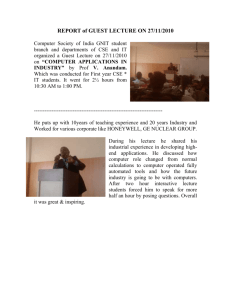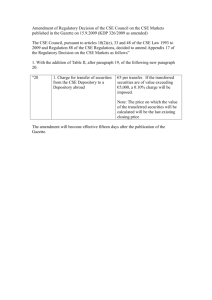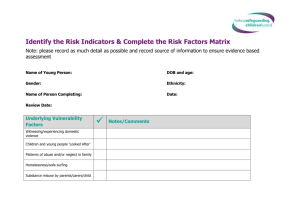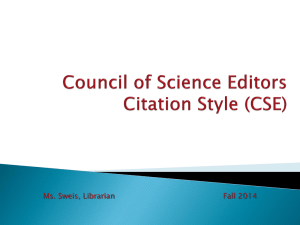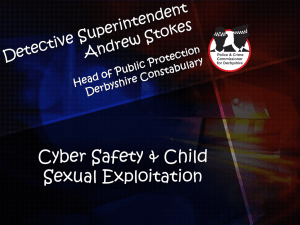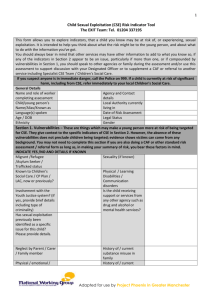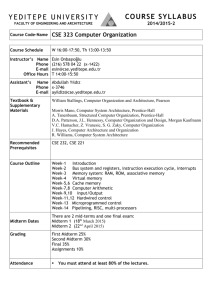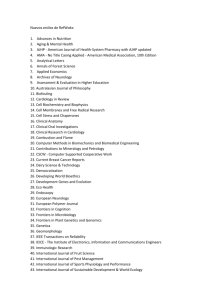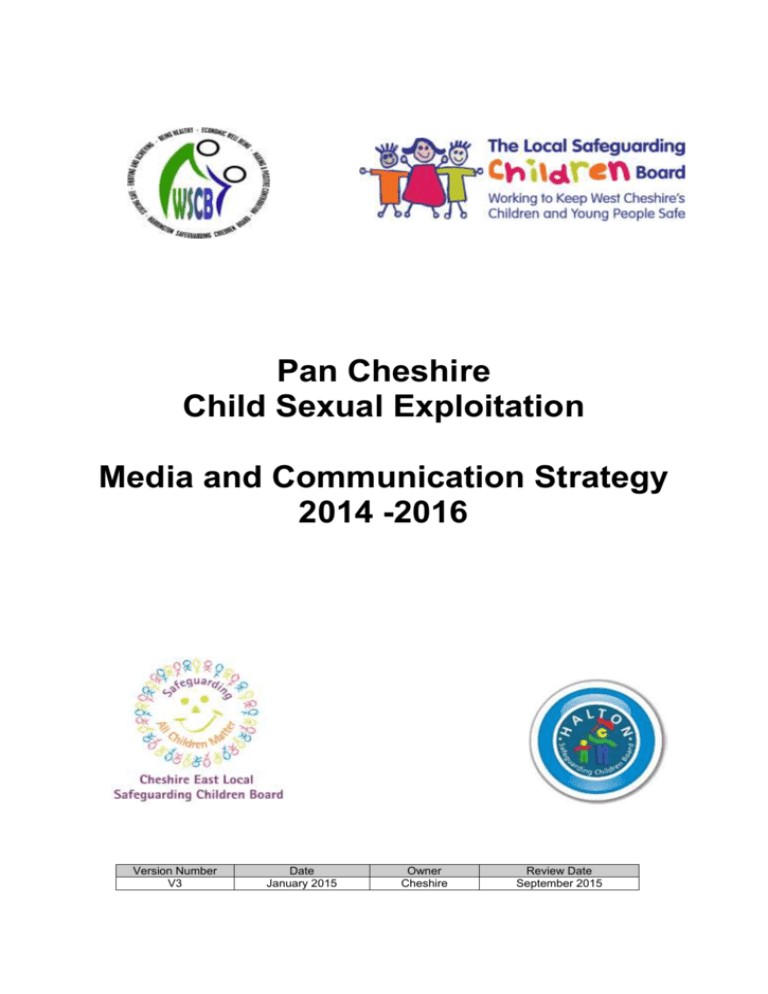
Pan Cheshire
Child Sexual Exploitation
Media and Communication Strategy
2014 -2016
Version Number
V3
Date
January 2015
Owner
Cheshire
Review Date
September 2015
Background
The Safeguarding Children’s Boards of Cheshire (Cheshire East, Cheshire West and Chester, Halton
and Warrington) have identified tackling the sexual exploitation of children as a key strategic priority.
Child Sexual Exploitation (CSE) is child abuse and is completely unacceptable. The Safeguarding
Children’s Boards of Cheshire (LSCB’s) are committed to combating the sexual exploitation of
children via effective multi agency and partnership working.
Each of the LSCB’s has their own CSE Operational Group that report to their respective board. They
all work and coordinate activity through a Pan Cheshire CSE Steering Group that is chaired by
Cheshire Police.
This group has developed a Pan Cheshire CSE Strategy and a supporting CSE Action Plan. This
includes a requirement to develop a CSE Communication Strategy.
In accordance with the Pan Cheshire CSE Action Plan, the following Communication and Awareness
Strategy has been developed through a task and finish group reporting to the Pan Cheshire CSE
Steering Group.
This strategy has been developed to assist and support each of the LSCB’s CSE sub groups in
engaging with the public, professionals and key stakeholders and especially those at risk of child
sexual exploitation.
It is important that we engage with the public and partners to raise awareness and understanding of
those at risk of CSE.
It is critical to both victim and public confidence that there is a multi agency commitment to CSE and
that communications activity reflects current service provision to victims and perpetrators of CSE.
In order to develop this strategy and then implement it across all agencies and professionals, a
consistent message must be communicated; this includes a consistent definition of what is CSE.
Those speaking about CSE must be able to clearly explain what CSE is in a way that the public can
understand.
The Cheshire LSCB’s has adopted the definition of sexual exploitation that is set out in statutory
guidance:
“Sexual exploitation is child abuse and children and young people
who become involved face huge risks to their physical, emotional
and psychological health and well- being.”
Sexual exploitation of children and young people under 18 involves exploitative situations, contexts
and relationships where young people (or a third person or persons) receive ‘something’ (e.g. food,
accommodation, drugs, alcohol, cigarettes, affection, attention, gifts, money) as a result of them
performing, or others performing on them, sexual acts or activities. Child sexual exploitation grooming
can occur through the use of technology without the child’s immediate recognition; for example being
persuaded to post sexual images on the Internet/mobile phones without immediate payment or gain.
In all cases, those exploiting the child/young person have power over them by virtue of their age,
gender, intellect, physical strength and/or economic or other resources. Violence, coercion and
intimidation are common, involvement in exploitative relationships being characterised in the main by
the child or young person’s limited availability of choice resulting from their social/economic and/or
emotional vulnerability (The Department of Children, Schools and Families and the Home Office, July
2009)
2
Any reference to Cheshire within this document refers to the Unitary Authorities of Cheshire East and
Cheshire West & Chester, Halton and Warrington.
Communications objectives:
Raise public awareness and understanding of CSE and the warning signs with the aim of
increasing reporting
Raise awareness and understanding of CSE and the warning signs across all professionals
who have a responsibility for the care and safety of young people. Professionals are aware of
the warning signs of CSE and are able to make informed decisions concerning the
identification and investigation of CSE
To provide the relevant communications tools that will aid accurate, informed and balanced
reporting of CSE and the multi agency response
Promote good work done nationally and locally by all agencies and partners using appropriate
communication channels
Ensure there is a coordinated local multi agency response to communicating issues relating to
CSE
Strategy aims:
Provide Pan Cheshire key messages that reflect the national key messages around CSE for
communication purposes that resonate with individual key target audiences locally
Provide guidance on identifying opportunities to communicate CSE and the Pan Cheshire
response to the public
To ensure a coordinated, structured and accountable approach to media and communications
Governance and Accountability:
It is important that this activity is driven and directed through the LSCB’s. This provides a high level of
scrutiny and accountability, through this multi agency platform. However, the respective groups have
authority to progress with activity to ensure that business progressed is an effective and timely
manner. It would not be acceptable for activity to be hindered or delayed due to the time period
between board meetings or coordinating responses across the boards.
The Pan Cheshire CSE Steering Group will own this strategy and associated Action Plan. The action
plan activity will be driven and coordinated through this group, with activity carried out through the
sub groups and task and finish groups as required. The Pan Cheshire Group reports to each of the
four LSCB’s across Cheshire. There is a standing agenda item and the chair of this group prepares a
briefing paper for each board meeting.
Each of the four Operational CSE Sub Groups are represented on the Pan Cheshire Group. They
also report directly through their Chairs to their respective LSCB.
Target audiences:
This strategy is aimed at communicating with a wide range of professionals, agencies and the public.
Certain activity and campaigns will be focused and specific to target groups or agencies as required
achieving the objectives. The following target audiences and stakeholders are identified; this list is by
no means exhaustive. The strategy will be flexible to fit with a changing landscape and responding to
regional and national activity.
Internal:
Local Safeguarding Children’s Board’s
o All agencies, professionals and voluntary sector engaged with or part of each of the
LSCB’s
3
Stakeholders:
Crown Prosecution Service (CPS)
Association of Police and Crime Commissioners (APCC)
NHS England
External
General public with particular emphasis on potential victims and their carers
Communications approach
Internally and to stakeholders:
Reporting through Pan Cheshire Steering Group to each LSCB
Reporting through CSE Sub Groups to respective LSCB
CSE Sub Groups to report to Pan Cheshire Steering Group
Externally and to stakeholders:
Support National Activity and Campaigns, driven through the CSE Steering Group.
Identify ways of communicating the CSE definition, warning signs and key messages to the
public. This could be through:
o Responding to reactive media enquiries- as a result of operational activity, court
cases, or speculative enquiries as a result of news reports, documentaries, specific
interest of the reporter or comments made by a stakeholder, politician or campaigner.
o Proactive media engagement- responding to CSE reports or publications, during a
court case of a CSE offender, during an arrest operation, when there has been a
national or local success in tackling CSE or on the back of wider discussions on CSE
in the media or a link to other events such as Universal Children’s Day or Safer
Internet Day.
Identify ways of reaching potential victims and parents- articles in teen magazines, videos on
You Tube, targeted campaigns on Facebook and Twitter and creating education packages for
schools.
Identify ways of reaching those who work with potential victims- pieces in trade press for
teaching, social services and health services.
Identify forces with best practice in dealing with CSE and build case studies of their success.
Narrative:
Tone
Emphasise the positive work being done in tackling CSE but also make it clear there is more
to do and a plan is in place to further improve the multi agency response
Awareness of CSE and the multi agency response are the key messages for all target
audiences
If talking about one form of CSE, ensure reference the wider definition
Language is important. Authorities have previously referred to victims as ‘promiscuous’,
‘prostitutes’ or ‘consenting’, which is completely unacceptable. A child abused by an adult in a
position of power is not able to consent
The use of the term “historic” has also been debated as it has been seen to undermine the
victim’s experience as for them the abuse is not historic; they are still living with it. Nonrecent is a more neutral word to use
Key messages:
Awareness of CSE:
Child sexual exploitation (CSE) is a form of child abuse where the victim is given somethingfood, money, drugs, alcohol, gifts- in exchange for sexual activity with the abuser. Offenders
4
target vulnerable young people and use their power- physical, financial, emotional etc- over
the child to sexually abuse them
Violence, coercion and intimidation are common. Involvement in exploitative relationships is
characterised by the child or young person’s limited availability of choice as a result of their
social, economic or emotional vulnerability
A common feature of CSE is that the child or young person does not recognise the coercive
nature of the relationship and does not see themselves as a victim of exploitation. This
means that they are unlikely to report the abuse so police and partners must be alert to the
signs of CSE and actively look for victims
CSE can occur through the use of technology without the child’s immediate recognition; for
example being persuaded to post images on the internet/ mobile phones without immediate
payment or gain
Following high profile CSE cases in places such as Rochdale and Rotherham and allegations
of child sex abuse against Jimmy Savile and others, we have all learnt much more about child
abuse and child sexual exploitation. As a society, we have a greater understanding of CSE
and a growing intolerance of it
There is not one type of victim or offender of CSE. CSE can take many forms in many
settings. If we look at just one model, such as group or gang CSE, we risk missing other
victims who do not fall into that category. There is also a risk that victims don’t recognise their
abuse as CSE because it doesn’t fit a particular model
CSE is not an indictable offence but police and prosecutors can charge offenders with rape
and other sexual offences as well as kidnapping and trafficking
Example - Materials that have already been developed for Phase 1 in 2014
A4 posters
5
Staff Aide Memoir
6
CSE teenagers information card
7
Phase 2 Communication activity
Period
October 2014
Audience
School and Education
17th November
2014
19th January
2015
Residential Children’s
Care Homes
Foster Carers
young people, parents
and general public
9th February
2015
Hotels and Taxi
drivers
23rd March
2015
GP’s surgeries, health
clinics, pharmacies,
25th May 2015
Late night economy
(Fast-food outlets,
Take away, pubs,
clubs)
Resource / Materials
A4 posters
CSE Teenagers information card A6
Stickers for inside changing rooms/toilet cubicles
Posters for Staff Rooms highlighting the signs
Updated website. www.knowandsee.co.uk
A4 posters
CSE Teenagers information card A6
Posters for Staff Rooms highlighting the signs
Use of Social Media- use of a national #, websites,
Facebook and Twitter accounts to engage with the
public and get their opinions on the campaign. Live
Tweets to run at times during the week highlighting
partnership activities. Live chat forum answer
questions from members of the public.
Posters for hotel staff – signs of CSE (Cleaning
cupboards, locker rooms, staff rooms)
Stickers for hotel staff (Staff toilets, changing areas
etc.)
Desk calendars for reception areas in hotels.
Book marks
Stress ball
Cups
Stickers for inside taxi’s: One to be displayed to
remind the driver of CSE, one for rear window in cab
for potential victims.
Car air fresheners
Posters for staff in surgeries – signs of CSE
Stickers for inside public toilet
A4 posters
Desk calendars
Window stickers
Posters staff – signs of CSE
A4 posters
Desk calendars
Window stickers
Stickers for inside public toilet
Business page within www.knowandsee.co.uk
Additional materials and resources will be added through 2015 and the below page shows some
examples of the materials produced.
8
Example - Materials that have already been developed for Phase 2 in 2015
Posters for Hotels
Inside of Buses
Air Fresheners
9

